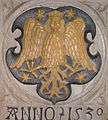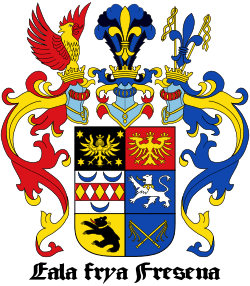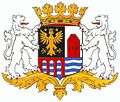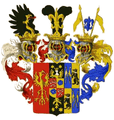Cirksena

The Cirksena are a noble East Frisian family descended from a line of East Frisian chieftains from Greetsiel.
The Cirksena in East Frisia
In 1439 in the wake of clashes between different lines of chieftains, the town of Emden was first placed by Hamburg under direct rule and then, in 1453, finally given to the Cirksenas. The family administered and ruled the town until 1595.
The Cirksena gained strength and succeeded the chieftain line of the tom Broks, after their opponent Focko Ukena was defeated and expelled by several allied chieftains, led by Edzard Cirksena. Ulrich Cirksena (d 1466) was elevated to the rank of imperial count by Emperor Frederick III and enfeoffed with the Imperial County of East Frisia.
The most important rule from the House of Cirksena was Edzard the Great (1462–1528), under whose leadership the Imperial County of East Frisia reached its greatest extent. During his reign the Reformation spread throughout East Frisia. In 1654 the Cirksena were elevated to princes by the emperor. Charles Edzard, the last ruler from the House of Cirksena, died without issue during the night of 25/26 May 1744 (reportedly from a glass of buttermilk, which he is said to have drunk after a hunt). Immediately thereafter, the state was taken over by Frederick the Great.
The Cirksena in Rietberg
The Cirksena provided the rulers of the County of Rietberg from 1581 to 1699. This initially happened as a personal union with East Frisia, after Count Enno III had married Rietberg's daughter-heir, Walburg von Rietberg. In the Treaty of Berum (1600) however he ceded the County of Rietberg to his daughters.
In 1601 Enno's brother, Count John III, married his niece, Sabina Catherine, Enno's daughter and heiress of Rietberg, with papal dispensation. Both were converted to Catholicism and so founded the Catholic branch line of the House of Cirksena. The last male descendant of the House of East Frisia in Rietberg, Count Ferdinand Maximilian, died in 1687. His heiress, Maria Ernestine Francisca, married Maximilian Ulrich of Kaunitz in 1699.
Coat of arms
The coat of arms of the family of Cirksena displays a crowned, golden harpy (or angel) on a black field. This motif appears in a variety of successor coats of arms. For example, in the final comital coat of arms of East Frisia, which Count Rudolf Christian adopted in 1625. Here the harpy is in the upper left of the shield. This coat of arms is still used today as the emblem of East Frisia.
The upper half of Emden's coat of arms also depicts the Cirksena harpy. Until the Emden Revolution in 1595, the Cirksena resided in the town of Emden. Even the Dutch town of Delfzijl opposite Emden has the incorporated the Cirksena coat of arms into its own. This goes back to the rule of Edzard the Great in Groningerland. Likewise the harpy is part of the coat of arms of Aurich district, albeit in a different colour, something which also goes back to the Cirksena. Even the present day municipality of Krummhörn, in which the ancestral homeland of the Cirksena lay, has the family's coat of arms in its municipal shield.
After the Cirksena had taken over the reins of power in the County of Rietberg, their emblem was also found in Rietberg's coat of arms, between the coat of arms of the old ruling family and that of the Harlingerland. It was later supplemented by the Kaunitz family's coat of arms.
Through the link between East Frisia and Rietberg the Cirksena harpy is still part of the coat of arms of the Principality of in Liechtenstein, albeit in the reverse colours (black and gold), at the bottom right (heraldic: bottom left). Gundakar of Liechtenstein had married Agnes Cirksena, the second daughter of Count Enno III and Walburgis of Rietberg, and had a claim to Rietberg as a result.
-

Cirksena coat of arms
-

Coat of arms of East Frisia
-

Emden coat of arms
-

Coat of arms of Delfzijl
-

Coat of arms of Aurich district
-

Coat of arms of Liechtenstein
-

Coat of arms of the Kaunitz-Rietberg family
-

Coat of arms of Krummhörn
Origin of the name
The name Cirksena is of Frisian origin and is still a widespread family name in East Frisia today. It probably goes back to the old forename Tzirk (Cirk). Enno Attena took over the respectable name on the occasion of his marriage to the daughter-heir, Gela Syardsna of Manslagt.
See also
Sources
- Hobbing, Hans Heinrich (1915). Die Begründung der Erstgeburtsnachfolge im ostfriesischen Grafenhaus der Cirksena. Aurich(Abhandlungen und Vorträge zur Geschichte Ostfrieslands, 19)
- Reimers, Heinrich (1925) Ostfriesland bis zum Aussterben seines Fürstenhauses. Bremen
- Esselborn, Ernst (1945). Das Geschlecht Cirksena. Berlin
External links
- Marek, Miroslav. "Genealogy of the Cirksena". Genealogy.EU.